Challenges in Residential Condominium Construction in Seattle
VerifiedAdded on 2019/09/30
|13
|2920
|277
Report
AI Summary
The residential condominium construction market in Seattle is facing challenges due to a decrease in demand for home ownership. Despite the high cost of renting apartments ($1800 per month), only 6.5% of renters can afford to buy a condominium, and many prefer to rent initially before committing to buying. This has led to a shift towards building apartments rather than condos, as they provide higher rents with less risk. The median home prices in downtown Seattle have increased by 18%, but the total sales volume has decreased due to a lack of affordable options. To address these challenges, making reservations for presales can be an effective solution.
Contribute Materials
Your contribution can guide someone’s learning journey. Share your
documents today.
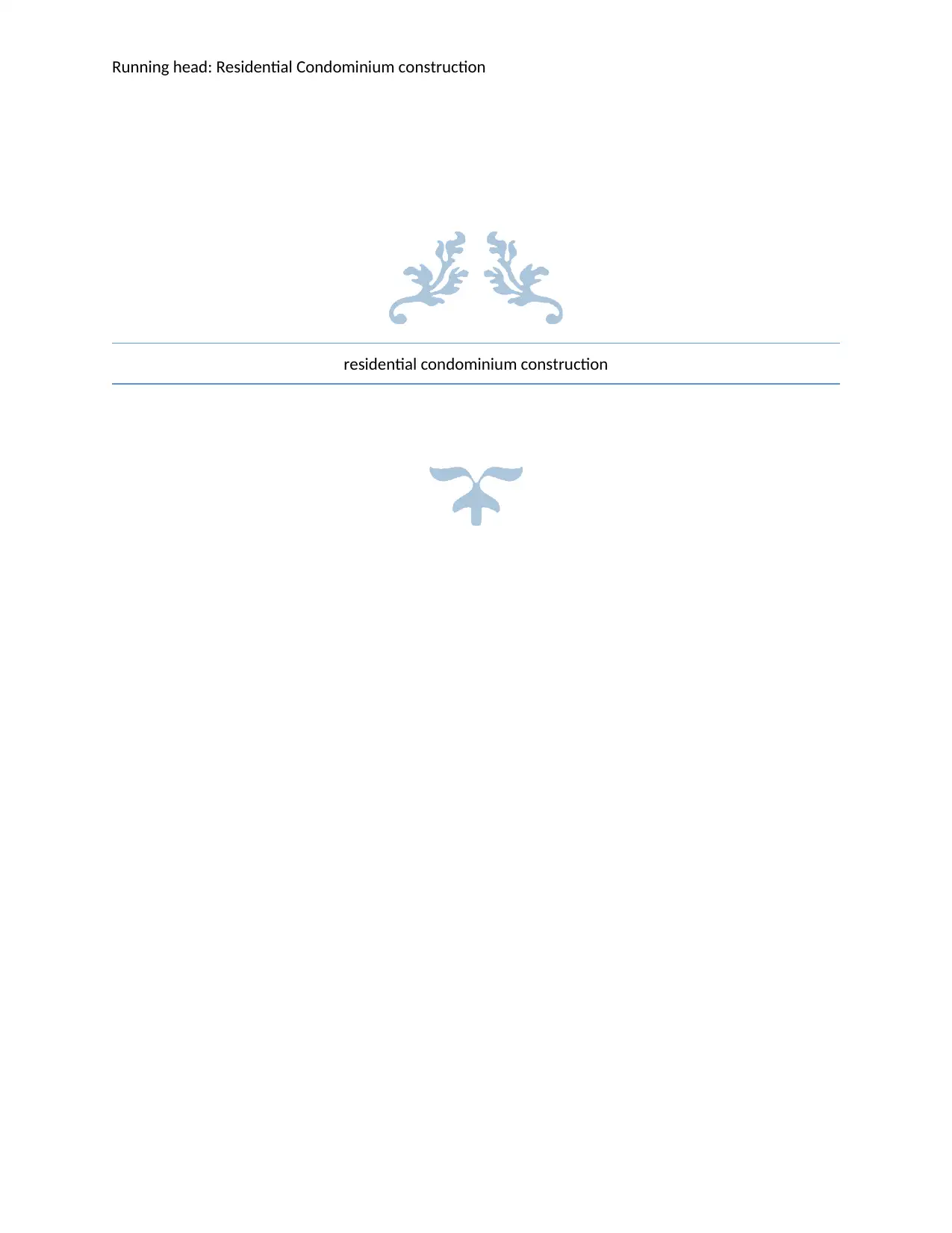
Running head: Residential Condominium construction
residential condominium construction
residential condominium construction
Secure Best Marks with AI Grader
Need help grading? Try our AI Grader for instant feedback on your assignments.

Residential Condominium construction 1
Table of Contents
Introduction...............................................................................................................................................2
Residential condominiums........................................................................................................................2
Different terms used for condominium in different countries................................................................3
Residential condominium construction in the United States..................................................................3
Reasons for increased number of residential condominiums in the United States...............................4
Residential condominium construction in Vancouver, B.C....................................................................5
Residential condominium construction in Seattle...................................................................................7
Reason for low residential condominium construction in Seattle..........................................................7
The ways through which this situation can be improved.......................................................................8
Conclusion..................................................................................................................................................9
References................................................................................................................................................10
Table of Contents
Introduction...............................................................................................................................................2
Residential condominiums........................................................................................................................2
Different terms used for condominium in different countries................................................................3
Residential condominium construction in the United States..................................................................3
Reasons for increased number of residential condominiums in the United States...............................4
Residential condominium construction in Vancouver, B.C....................................................................5
Residential condominium construction in Seattle...................................................................................7
Reason for low residential condominium construction in Seattle..........................................................7
The ways through which this situation can be improved.......................................................................8
Conclusion..................................................................................................................................................9
References................................................................................................................................................10
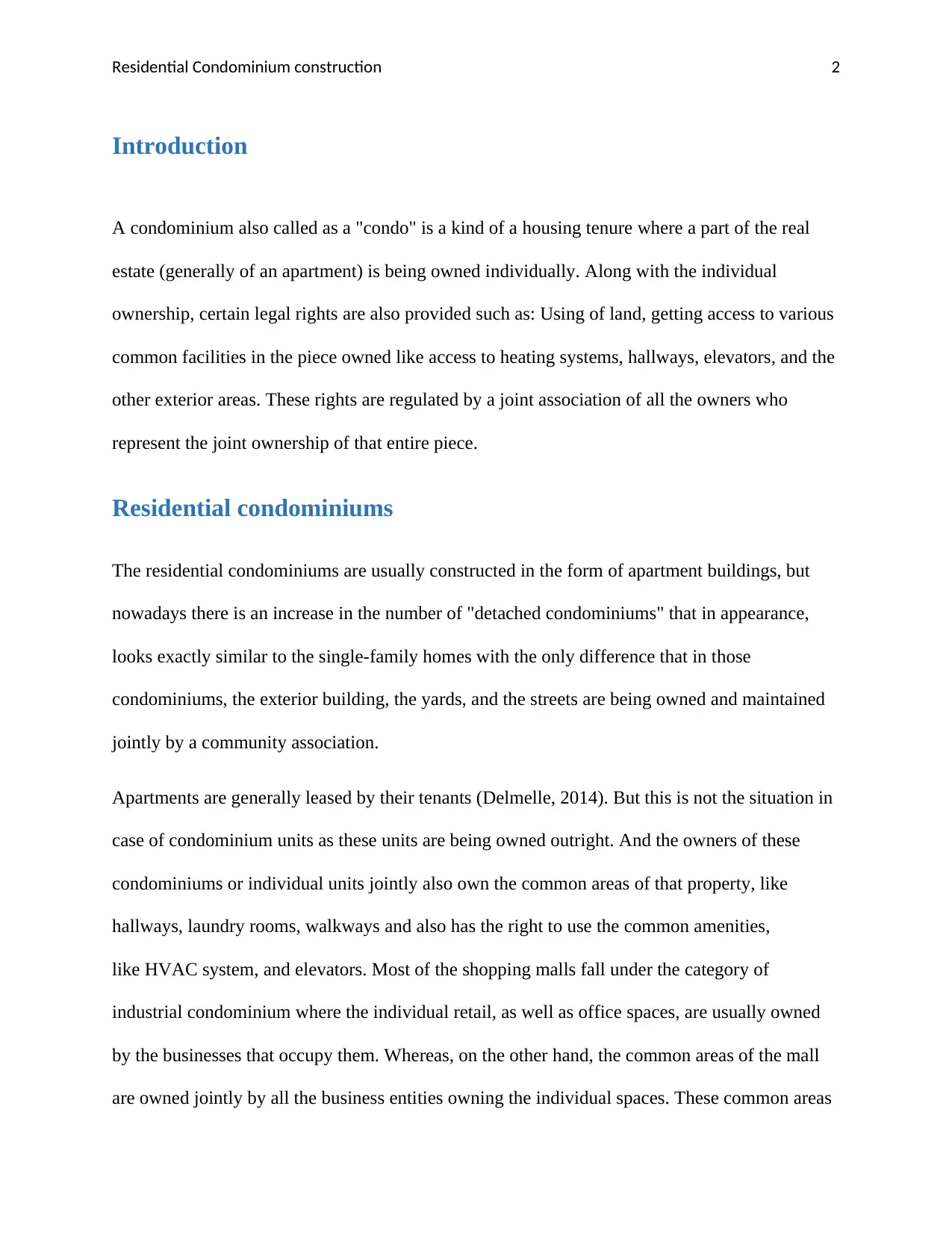
Residential Condominium construction 2
Introduction
A condominium also called as a "condo" is a kind of a housing tenure where a part of the real
estate (generally of an apartment) is being owned individually. Along with the individual
ownership, certain legal rights are also provided such as: Using of land, getting access to various
common facilities in the piece owned like access to heating systems, hallways, elevators, and the
other exterior areas. These rights are regulated by a joint association of all the owners who
represent the joint ownership of that entire piece.
Residential condominiums
The residential condominiums are usually constructed in the form of apartment buildings, but
nowadays there is an increase in the number of "detached condominiums" that in appearance,
looks exactly similar to the single-family homes with the only difference that in those
condominiums, the exterior building, the yards, and the streets are being owned and maintained
jointly by a community association.
Apartments are generally leased by their tenants (Delmelle, 2014). But this is not the situation in
case of condominium units as these units are being owned outright. And the owners of these
condominiums or individual units jointly also own the common areas of that property, like
hallways, laundry rooms, walkways and also has the right to use the common amenities,
like HVAC system, and elevators. Most of the shopping malls fall under the category of
industrial condominium where the individual retail, as well as office spaces, are usually owned
by the businesses that occupy them. Whereas, on the other hand, the common areas of the mall
are owned jointly by all the business entities owning the individual spaces. These common areas
Introduction
A condominium also called as a "condo" is a kind of a housing tenure where a part of the real
estate (generally of an apartment) is being owned individually. Along with the individual
ownership, certain legal rights are also provided such as: Using of land, getting access to various
common facilities in the piece owned like access to heating systems, hallways, elevators, and the
other exterior areas. These rights are regulated by a joint association of all the owners who
represent the joint ownership of that entire piece.
Residential condominiums
The residential condominiums are usually constructed in the form of apartment buildings, but
nowadays there is an increase in the number of "detached condominiums" that in appearance,
looks exactly similar to the single-family homes with the only difference that in those
condominiums, the exterior building, the yards, and the streets are being owned and maintained
jointly by a community association.
Apartments are generally leased by their tenants (Delmelle, 2014). But this is not the situation in
case of condominium units as these units are being owned outright. And the owners of these
condominiums or individual units jointly also own the common areas of that property, like
hallways, laundry rooms, walkways and also has the right to use the common amenities,
like HVAC system, and elevators. Most of the shopping malls fall under the category of
industrial condominium where the individual retail, as well as office spaces, are usually owned
by the businesses that occupy them. Whereas, on the other hand, the common areas of the mall
are owned jointly by all the business entities owning the individual spaces. These common areas
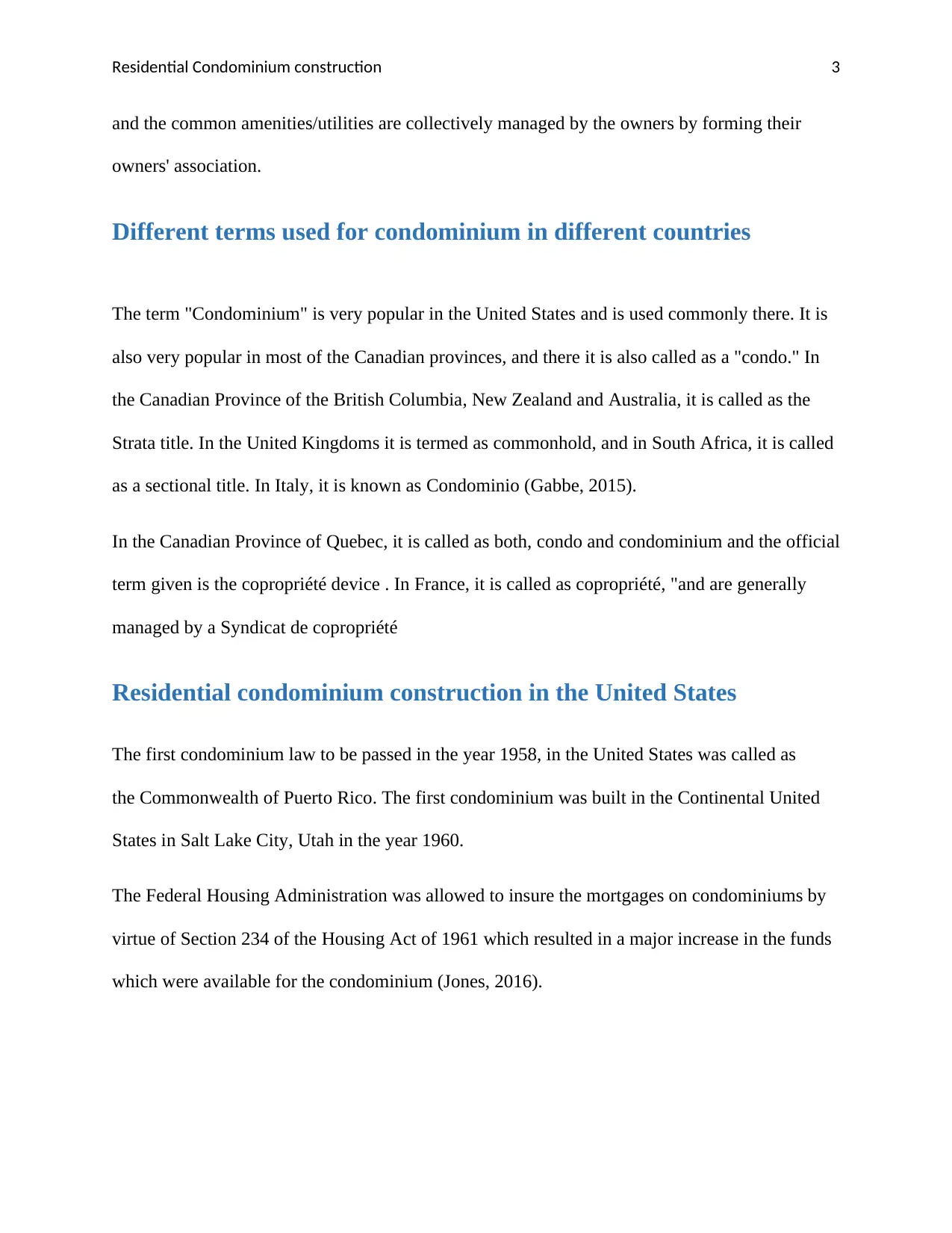
Residential Condominium construction 3
and the common amenities/utilities are collectively managed by the owners by forming their
owners' association.
Different terms used for condominium in different countries
The term "Condominium" is very popular in the United States and is used commonly there. It is
also very popular in most of the Canadian provinces, and there it is also called as a "condo." In
the Canadian Province of the British Columbia, New Zealand and Australia, it is called as the
Strata title. In the United Kingdoms it is termed as commonhold, and in South Africa, it is called
as a sectional title. In Italy, it is known as Condominio (Gabbe, 2015).
In the Canadian Province of Quebec, it is called as both, condo and condominium and the official
term given is the copropriété device . In France, it is called as copropriété, "and are generally
managed by a Syndicat de copropriété
Residential condominium construction in the United States
The first condominium law to be passed in the year 1958, in the United States was called as
the Commonwealth of Puerto Rico. The first condominium was built in the Continental United
States in Salt Lake City, Utah in the year 1960.
The Federal Housing Administration was allowed to insure the mortgages on condominiums by
virtue of Section 234 of the Housing Act of 1961 which resulted in a major increase in the funds
which were available for the condominium (Jones, 2016).
and the common amenities/utilities are collectively managed by the owners by forming their
owners' association.
Different terms used for condominium in different countries
The term "Condominium" is very popular in the United States and is used commonly there. It is
also very popular in most of the Canadian provinces, and there it is also called as a "condo." In
the Canadian Province of the British Columbia, New Zealand and Australia, it is called as the
Strata title. In the United Kingdoms it is termed as commonhold, and in South Africa, it is called
as a sectional title. In Italy, it is known as Condominio (Gabbe, 2015).
In the Canadian Province of Quebec, it is called as both, condo and condominium and the official
term given is the copropriété device . In France, it is called as copropriété, "and are generally
managed by a Syndicat de copropriété
Residential condominium construction in the United States
The first condominium law to be passed in the year 1958, in the United States was called as
the Commonwealth of Puerto Rico. The first condominium was built in the Continental United
States in Salt Lake City, Utah in the year 1960.
The Federal Housing Administration was allowed to insure the mortgages on condominiums by
virtue of Section 234 of the Housing Act of 1961 which resulted in a major increase in the funds
which were available for the condominium (Jones, 2016).
Secure Best Marks with AI Grader
Need help grading? Try our AI Grader for instant feedback on your assignments.
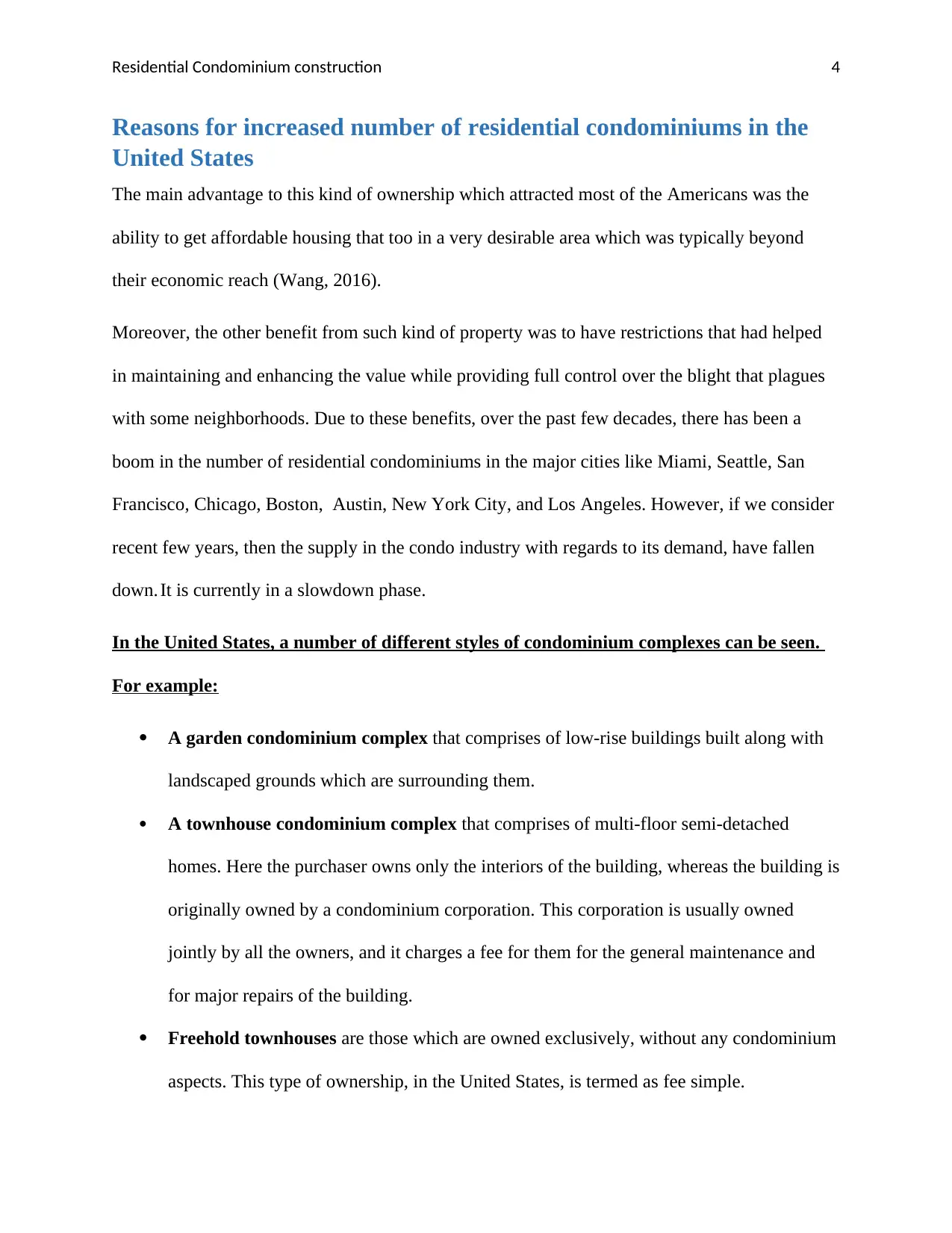
Residential Condominium construction 4
Reasons for increased number of residential condominiums in the
United States
The main advantage to this kind of ownership which attracted most of the Americans was the
ability to get affordable housing that too in a very desirable area which was typically beyond
their economic reach (Wang, 2016).
Moreover, the other benefit from such kind of property was to have restrictions that had helped
in maintaining and enhancing the value while providing full control over the blight that plagues
with some neighborhoods. Due to these benefits, over the past few decades, there has been a
boom in the number of residential condominiums in the major cities like Miami, Seattle, San
Francisco, Chicago, Boston, Austin, New York City, and Los Angeles. However, if we consider
recent few years, then the supply in the condo industry with regards to its demand, have fallen
down. It is currently in a slowdown phase.
In the United States, a number of different styles of condominium complexes can be seen.
For example:
A garden condominium complex that comprises of low-rise buildings built along with
landscaped grounds which are surrounding them.
A townhouse condominium complex that comprises of multi-floor semi-detached
homes. Here the purchaser owns only the interiors of the building, whereas the building is
originally owned by a condominium corporation. This corporation is usually owned
jointly by all the owners, and it charges a fee for them for the general maintenance and
for major repairs of the building.
Freehold townhouses are those which are owned exclusively, without any condominium
aspects. This type of ownership, in the United States, is termed as fee simple.
Reasons for increased number of residential condominiums in the
United States
The main advantage to this kind of ownership which attracted most of the Americans was the
ability to get affordable housing that too in a very desirable area which was typically beyond
their economic reach (Wang, 2016).
Moreover, the other benefit from such kind of property was to have restrictions that had helped
in maintaining and enhancing the value while providing full control over the blight that plagues
with some neighborhoods. Due to these benefits, over the past few decades, there has been a
boom in the number of residential condominiums in the major cities like Miami, Seattle, San
Francisco, Chicago, Boston, Austin, New York City, and Los Angeles. However, if we consider
recent few years, then the supply in the condo industry with regards to its demand, have fallen
down. It is currently in a slowdown phase.
In the United States, a number of different styles of condominium complexes can be seen.
For example:
A garden condominium complex that comprises of low-rise buildings built along with
landscaped grounds which are surrounding them.
A townhouse condominium complex that comprises of multi-floor semi-detached
homes. Here the purchaser owns only the interiors of the building, whereas the building is
originally owned by a condominium corporation. This corporation is usually owned
jointly by all the owners, and it charges a fee for them for the general maintenance and
for major repairs of the building.
Freehold townhouses are those which are owned exclusively, without any condominium
aspects. This type of ownership, in the United States, is termed as fee simple.
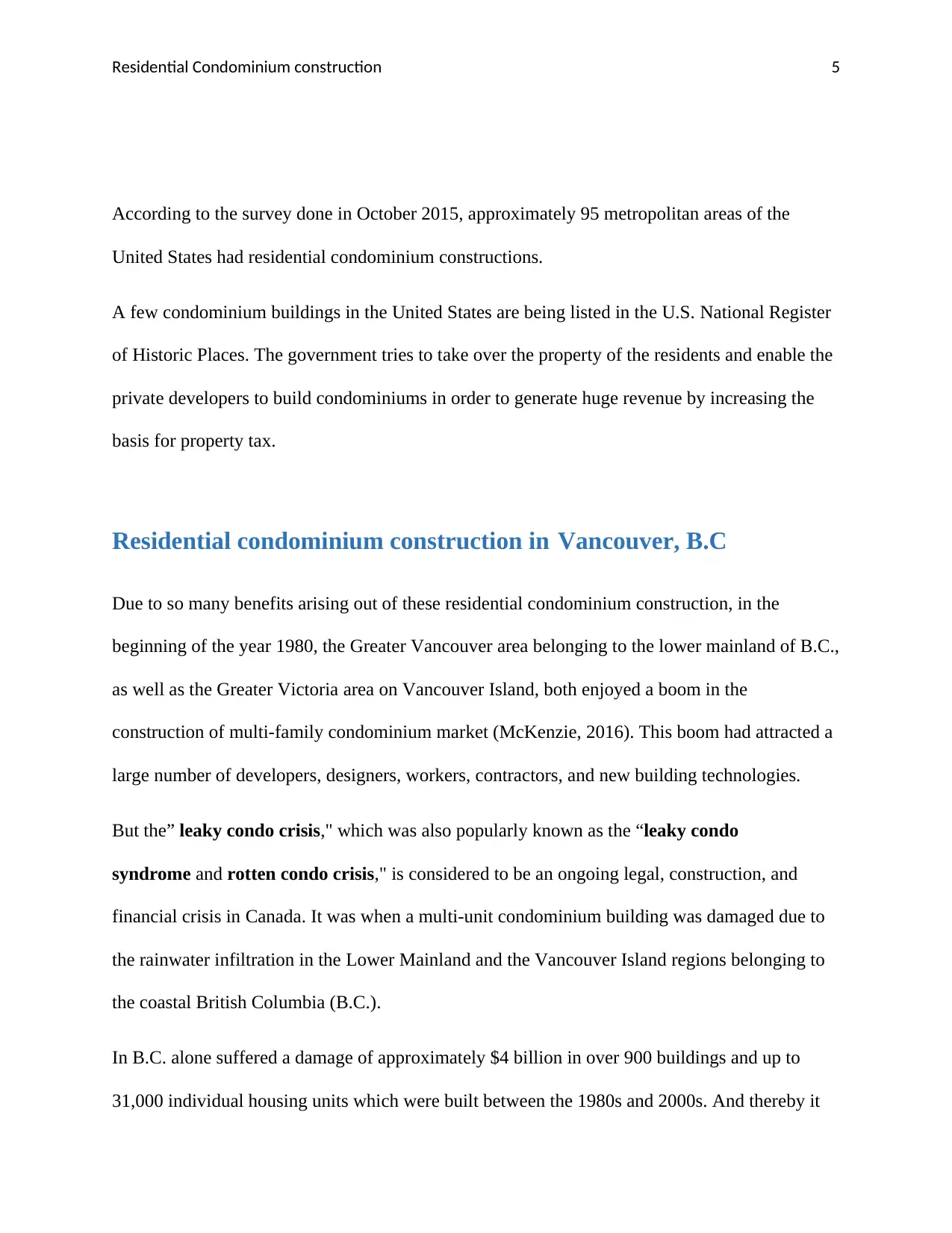
Residential Condominium construction 5
According to the survey done in October 2015, approximately 95 metropolitan areas of the
United States had residential condominium constructions.
A few condominium buildings in the United States are being listed in the U.S. National Register
of Historic Places. The government tries to take over the property of the residents and enable the
private developers to build condominiums in order to generate huge revenue by increasing the
basis for property tax.
Residential condominium construction in Vancouver, B.C
Due to so many benefits arising out of these residential condominium construction, in the
beginning of the year 1980, the Greater Vancouver area belonging to the lower mainland of B.C.,
as well as the Greater Victoria area on Vancouver Island, both enjoyed a boom in the
construction of multi-family condominium market (McKenzie, 2016). This boom had attracted a
large number of developers, designers, workers, contractors, and new building technologies.
But the” leaky condo crisis," which was also popularly known as the “leaky condo
syndrome and rotten condo crisis," is considered to be an ongoing legal, construction, and
financial crisis in Canada. It was when a multi-unit condominium building was damaged due to
the rainwater infiltration in the Lower Mainland and the Vancouver Island regions belonging to
the coastal British Columbia (B.C.).
In B.C. alone suffered a damage of approximately $4 billion in over 900 buildings and up to
31,000 individual housing units which were built between the 1980s and 2000s. And thereby it
According to the survey done in October 2015, approximately 95 metropolitan areas of the
United States had residential condominium constructions.
A few condominium buildings in the United States are being listed in the U.S. National Register
of Historic Places. The government tries to take over the property of the residents and enable the
private developers to build condominiums in order to generate huge revenue by increasing the
basis for property tax.
Residential condominium construction in Vancouver, B.C
Due to so many benefits arising out of these residential condominium construction, in the
beginning of the year 1980, the Greater Vancouver area belonging to the lower mainland of B.C.,
as well as the Greater Victoria area on Vancouver Island, both enjoyed a boom in the
construction of multi-family condominium market (McKenzie, 2016). This boom had attracted a
large number of developers, designers, workers, contractors, and new building technologies.
But the” leaky condo crisis," which was also popularly known as the “leaky condo
syndrome and rotten condo crisis," is considered to be an ongoing legal, construction, and
financial crisis in Canada. It was when a multi-unit condominium building was damaged due to
the rainwater infiltration in the Lower Mainland and the Vancouver Island regions belonging to
the coastal British Columbia (B.C.).
In B.C. alone suffered a damage of approximately $4 billion in over 900 buildings and up to
31,000 individual housing units which were built between the 1980s and 2000s. And thereby it
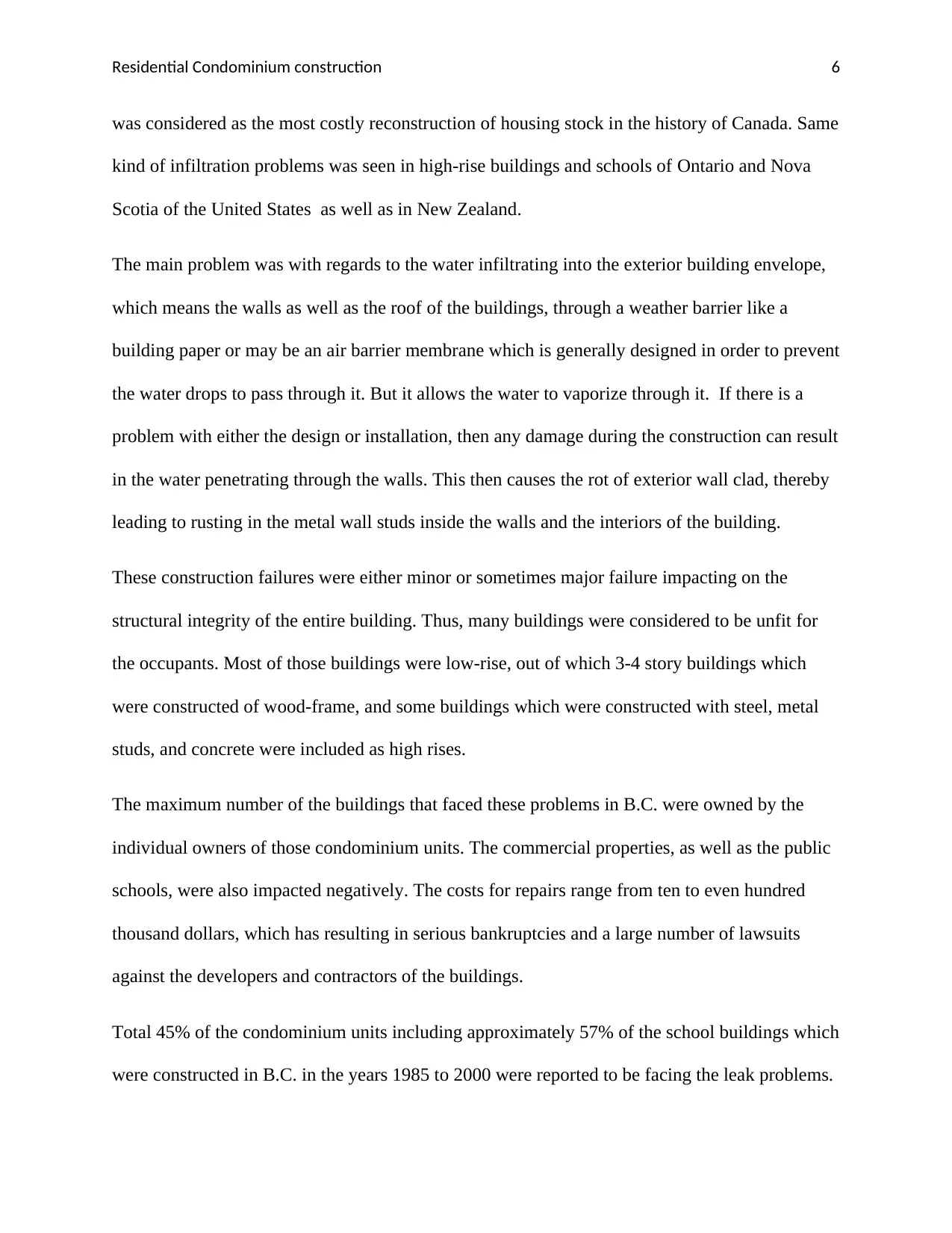
Residential Condominium construction 6
was considered as the most costly reconstruction of housing stock in the history of Canada. Same
kind of infiltration problems was seen in high-rise buildings and schools of Ontario and Nova
Scotia of the United States as well as in New Zealand.
The main problem was with regards to the water infiltrating into the exterior building envelope,
which means the walls as well as the roof of the buildings, through a weather barrier like a
building paper or may be an air barrier membrane which is generally designed in order to prevent
the water drops to pass through it. But it allows the water to vaporize through it. If there is a
problem with either the design or installation, then any damage during the construction can result
in the water penetrating through the walls. This then causes the rot of exterior wall clad, thereby
leading to rusting in the metal wall studs inside the walls and the interiors of the building.
These construction failures were either minor or sometimes major failure impacting on the
structural integrity of the entire building. Thus, many buildings were considered to be unfit for
the occupants. Most of those buildings were low-rise, out of which 3-4 story buildings which
were constructed of wood-frame, and some buildings which were constructed with steel, metal
studs, and concrete were included as high rises.
The maximum number of the buildings that faced these problems in B.C. were owned by the
individual owners of those condominium units. The commercial properties, as well as the public
schools, were also impacted negatively. The costs for repairs range from ten to even hundred
thousand dollars, which has resulting in serious bankruptcies and a large number of lawsuits
against the developers and contractors of the buildings.
Total 45% of the condominium units including approximately 57% of the school buildings which
were constructed in B.C. in the years 1985 to 2000 were reported to be facing the leak problems.
was considered as the most costly reconstruction of housing stock in the history of Canada. Same
kind of infiltration problems was seen in high-rise buildings and schools of Ontario and Nova
Scotia of the United States as well as in New Zealand.
The main problem was with regards to the water infiltrating into the exterior building envelope,
which means the walls as well as the roof of the buildings, through a weather barrier like a
building paper or may be an air barrier membrane which is generally designed in order to prevent
the water drops to pass through it. But it allows the water to vaporize through it. If there is a
problem with either the design or installation, then any damage during the construction can result
in the water penetrating through the walls. This then causes the rot of exterior wall clad, thereby
leading to rusting in the metal wall studs inside the walls and the interiors of the building.
These construction failures were either minor or sometimes major failure impacting on the
structural integrity of the entire building. Thus, many buildings were considered to be unfit for
the occupants. Most of those buildings were low-rise, out of which 3-4 story buildings which
were constructed of wood-frame, and some buildings which were constructed with steel, metal
studs, and concrete were included as high rises.
The maximum number of the buildings that faced these problems in B.C. were owned by the
individual owners of those condominium units. The commercial properties, as well as the public
schools, were also impacted negatively. The costs for repairs range from ten to even hundred
thousand dollars, which has resulting in serious bankruptcies and a large number of lawsuits
against the developers and contractors of the buildings.
Total 45% of the condominium units including approximately 57% of the school buildings which
were constructed in B.C. in the years 1985 to 2000 were reported to be facing the leak problems.
Paraphrase This Document
Need a fresh take? Get an instant paraphrase of this document with our AI Paraphraser

Residential Condominium construction 7
In the year 2008, the cost of repairing the damage was estimated as $400 million for schools
alone.
Residential condominium construction in Seattle
Seattle is considered to be among the top ten most expensive rental markets with a price of
$1800 per month for a one-bedroom apartment. It had more than 12500 new constructions as
surveyed in the year 2011. Even after this huge supply, the rents have shown an increase by 40%
which is due to the disparity between supply and demand (Easthope, 2014).
The developers of these new units of condominium provided for sale only 866 new
condominiums in the past five years which is really less in comparison to the construction of
12,500 apartments as surveyed in 2011. This suggests that the demand for home ownership is
only up to 6.5% in comparison to the population.
Reason for low residential condominium construction in Seattle
Recently it has been stated that approximately 22% of the renters in Seattle can afford to buy
these apartments. They have the capacity to buy in terms of incomes and credit scores. Still, the
question is why don't they still buy? In answer to this particular question, it was stated that in the
case of a new job, the new recruit would prefer renting an apartment initially in order to see if
his/her job works out or not, before making huge financial commitments.
Due to this there a change in the condominium market as the developers now preferred building
apartments as it provides them profits with comparatively less degree of risk and also imposes
less liability on them. The get the benefit in terms of high rents. Thus, huge investment funds are
In the year 2008, the cost of repairing the damage was estimated as $400 million for schools
alone.
Residential condominium construction in Seattle
Seattle is considered to be among the top ten most expensive rental markets with a price of
$1800 per month for a one-bedroom apartment. It had more than 12500 new constructions as
surveyed in the year 2011. Even after this huge supply, the rents have shown an increase by 40%
which is due to the disparity between supply and demand (Easthope, 2014).
The developers of these new units of condominium provided for sale only 866 new
condominiums in the past five years which is really less in comparison to the construction of
12,500 apartments as surveyed in 2011. This suggests that the demand for home ownership is
only up to 6.5% in comparison to the population.
Reason for low residential condominium construction in Seattle
Recently it has been stated that approximately 22% of the renters in Seattle can afford to buy
these apartments. They have the capacity to buy in terms of incomes and credit scores. Still, the
question is why don't they still buy? In answer to this particular question, it was stated that in the
case of a new job, the new recruit would prefer renting an apartment initially in order to see if
his/her job works out or not, before making huge financial commitments.
Due to this there a change in the condominium market as the developers now preferred building
apartments as it provides them profits with comparatively less degree of risk and also imposes
less liability on them. The get the benefit in terms of high rents. Thus, huge investment funds are
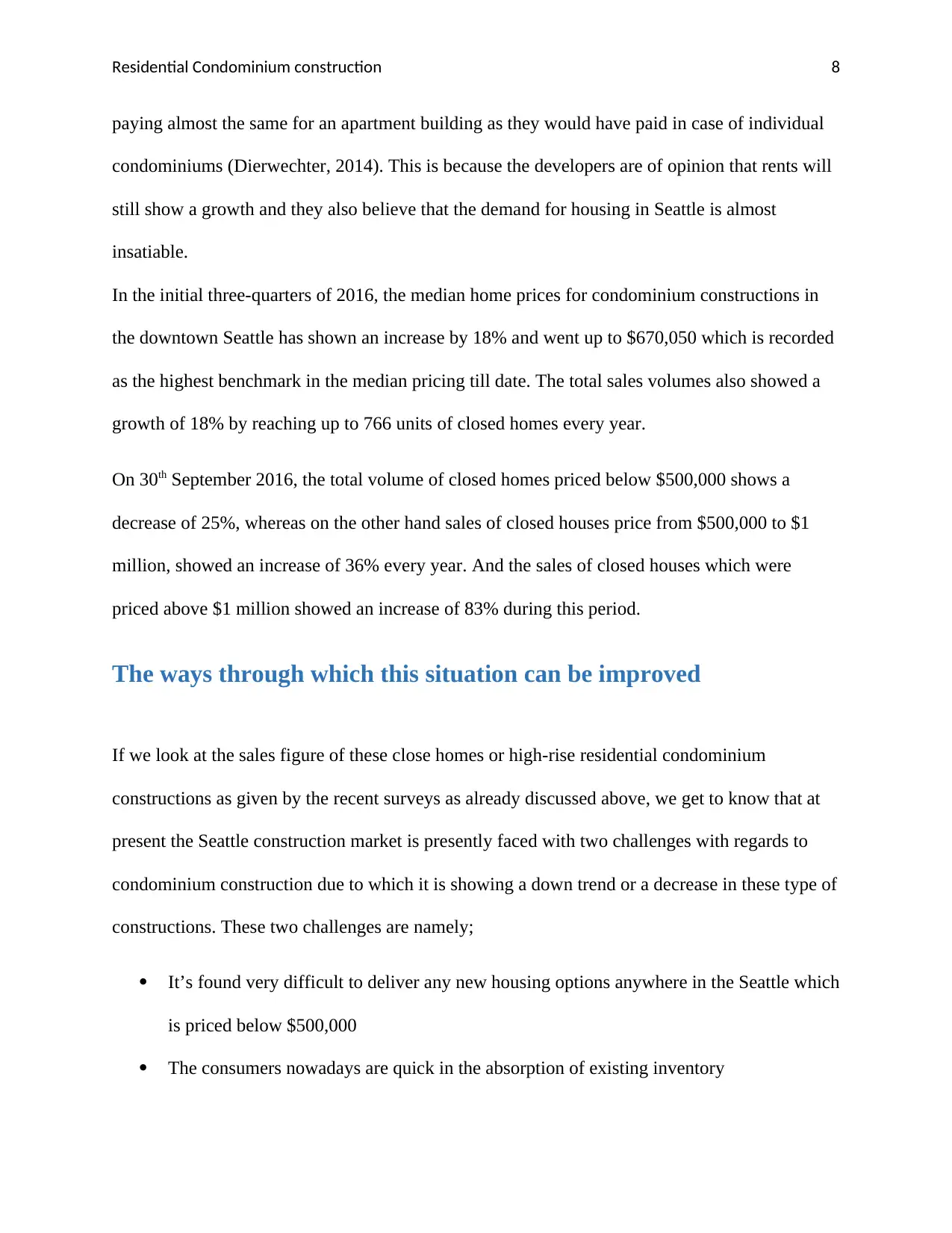
Residential Condominium construction 8
paying almost the same for an apartment building as they would have paid in case of individual
condominiums (Dierwechter, 2014). This is because the developers are of opinion that rents will
still show a growth and they also believe that the demand for housing in Seattle is almost
insatiable.
In the initial three-quarters of 2016, the median home prices for condominium constructions in
the downtown Seattle has shown an increase by 18% and went up to $670,050 which is recorded
as the highest benchmark in the median pricing till date. The total sales volumes also showed a
growth of 18% by reaching up to 766 units of closed homes every year.
On 30th September 2016, the total volume of closed homes priced below $500,000 shows a
decrease of 25%, whereas on the other hand sales of closed houses price from $500,000 to $1
million, showed an increase of 36% every year. And the sales of closed houses which were
priced above $1 million showed an increase of 83% during this period.
The ways through which this situation can be improved
If we look at the sales figure of these close homes or high-rise residential condominium
constructions as given by the recent surveys as already discussed above, we get to know that at
present the Seattle construction market is presently faced with two challenges with regards to
condominium construction due to which it is showing a down trend or a decrease in these type of
constructions. These two challenges are namely;
It’s found very difficult to deliver any new housing options anywhere in the Seattle which
is priced below $500,000
The consumers nowadays are quick in the absorption of existing inventory
paying almost the same for an apartment building as they would have paid in case of individual
condominiums (Dierwechter, 2014). This is because the developers are of opinion that rents will
still show a growth and they also believe that the demand for housing in Seattle is almost
insatiable.
In the initial three-quarters of 2016, the median home prices for condominium constructions in
the downtown Seattle has shown an increase by 18% and went up to $670,050 which is recorded
as the highest benchmark in the median pricing till date. The total sales volumes also showed a
growth of 18% by reaching up to 766 units of closed homes every year.
On 30th September 2016, the total volume of closed homes priced below $500,000 shows a
decrease of 25%, whereas on the other hand sales of closed houses price from $500,000 to $1
million, showed an increase of 36% every year. And the sales of closed houses which were
priced above $1 million showed an increase of 83% during this period.
The ways through which this situation can be improved
If we look at the sales figure of these close homes or high-rise residential condominium
constructions as given by the recent surveys as already discussed above, we get to know that at
present the Seattle construction market is presently faced with two challenges with regards to
condominium construction due to which it is showing a down trend or a decrease in these type of
constructions. These two challenges are namely;
It’s found very difficult to deliver any new housing options anywhere in the Seattle which
is priced below $500,000
The consumers nowadays are quick in the absorption of existing inventory
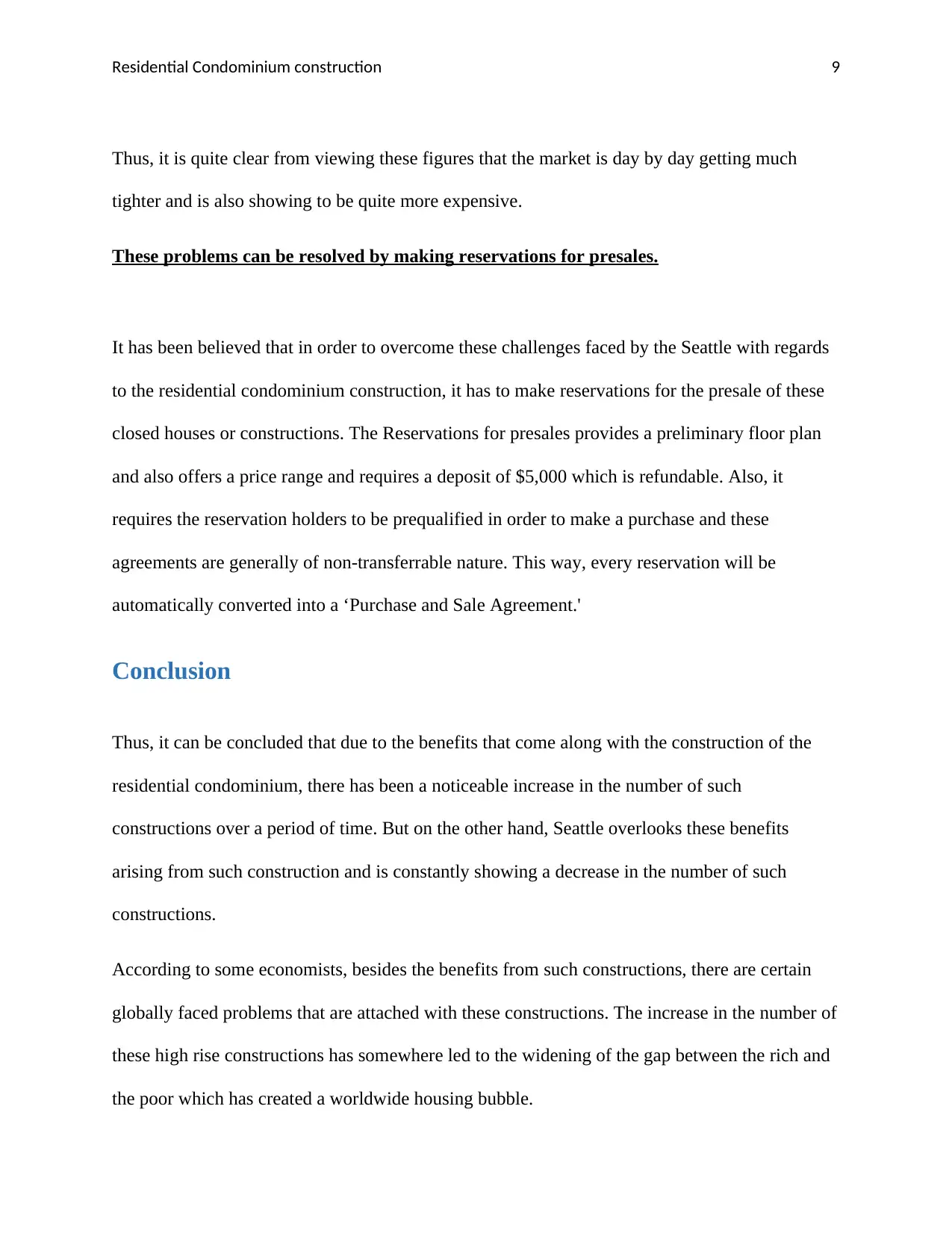
Residential Condominium construction 9
Thus, it is quite clear from viewing these figures that the market is day by day getting much
tighter and is also showing to be quite more expensive.
These problems can be resolved by making reservations for presales.
It has been believed that in order to overcome these challenges faced by the Seattle with regards
to the residential condominium construction, it has to make reservations for the presale of these
closed houses or constructions. The Reservations for presales provides a preliminary floor plan
and also offers a price range and requires a deposit of $5,000 which is refundable. Also, it
requires the reservation holders to be prequalified in order to make a purchase and these
agreements are generally of non-transferrable nature. This way, every reservation will be
automatically converted into a ‘Purchase and Sale Agreement.'
Conclusion
Thus, it can be concluded that due to the benefits that come along with the construction of the
residential condominium, there has been a noticeable increase in the number of such
constructions over a period of time. But on the other hand, Seattle overlooks these benefits
arising from such construction and is constantly showing a decrease in the number of such
constructions.
According to some economists, besides the benefits from such constructions, there are certain
globally faced problems that are attached with these constructions. The increase in the number of
these high rise constructions has somewhere led to the widening of the gap between the rich and
the poor which has created a worldwide housing bubble.
Thus, it is quite clear from viewing these figures that the market is day by day getting much
tighter and is also showing to be quite more expensive.
These problems can be resolved by making reservations for presales.
It has been believed that in order to overcome these challenges faced by the Seattle with regards
to the residential condominium construction, it has to make reservations for the presale of these
closed houses or constructions. The Reservations for presales provides a preliminary floor plan
and also offers a price range and requires a deposit of $5,000 which is refundable. Also, it
requires the reservation holders to be prequalified in order to make a purchase and these
agreements are generally of non-transferrable nature. This way, every reservation will be
automatically converted into a ‘Purchase and Sale Agreement.'
Conclusion
Thus, it can be concluded that due to the benefits that come along with the construction of the
residential condominium, there has been a noticeable increase in the number of such
constructions over a period of time. But on the other hand, Seattle overlooks these benefits
arising from such construction and is constantly showing a decrease in the number of such
constructions.
According to some economists, besides the benefits from such constructions, there are certain
globally faced problems that are attached with these constructions. The increase in the number of
these high rise constructions has somewhere led to the widening of the gap between the rich and
the poor which has created a worldwide housing bubble.
Secure Best Marks with AI Grader
Need help grading? Try our AI Grader for instant feedback on your assignments.
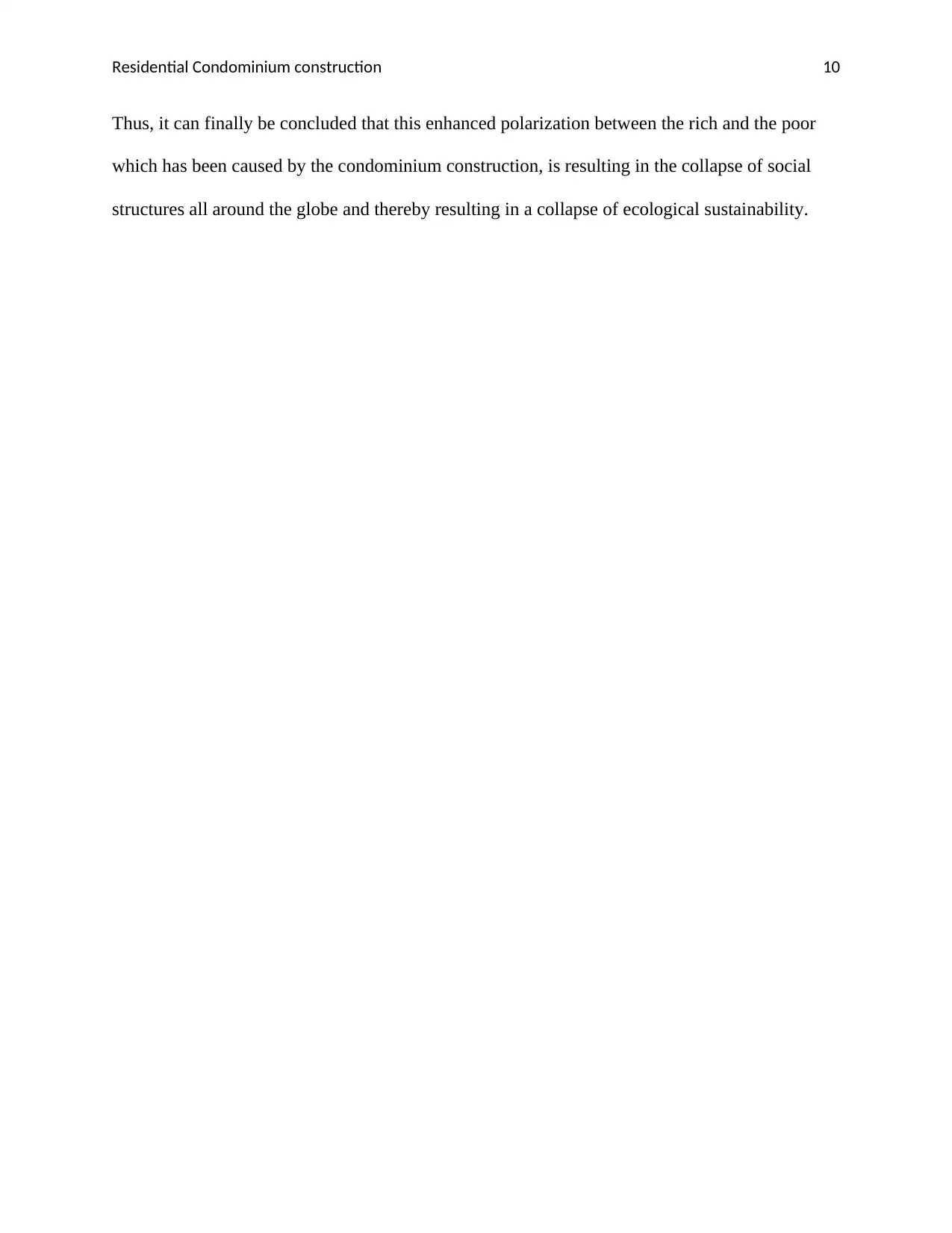
Residential Condominium construction 10
Thus, it can finally be concluded that this enhanced polarization between the rich and the poor
which has been caused by the condominium construction, is resulting in the collapse of social
structures all around the globe and thereby resulting in a collapse of ecological sustainability.
Thus, it can finally be concluded that this enhanced polarization between the rich and the poor
which has been caused by the condominium construction, is resulting in the collapse of social
structures all around the globe and thereby resulting in a collapse of ecological sustainability.
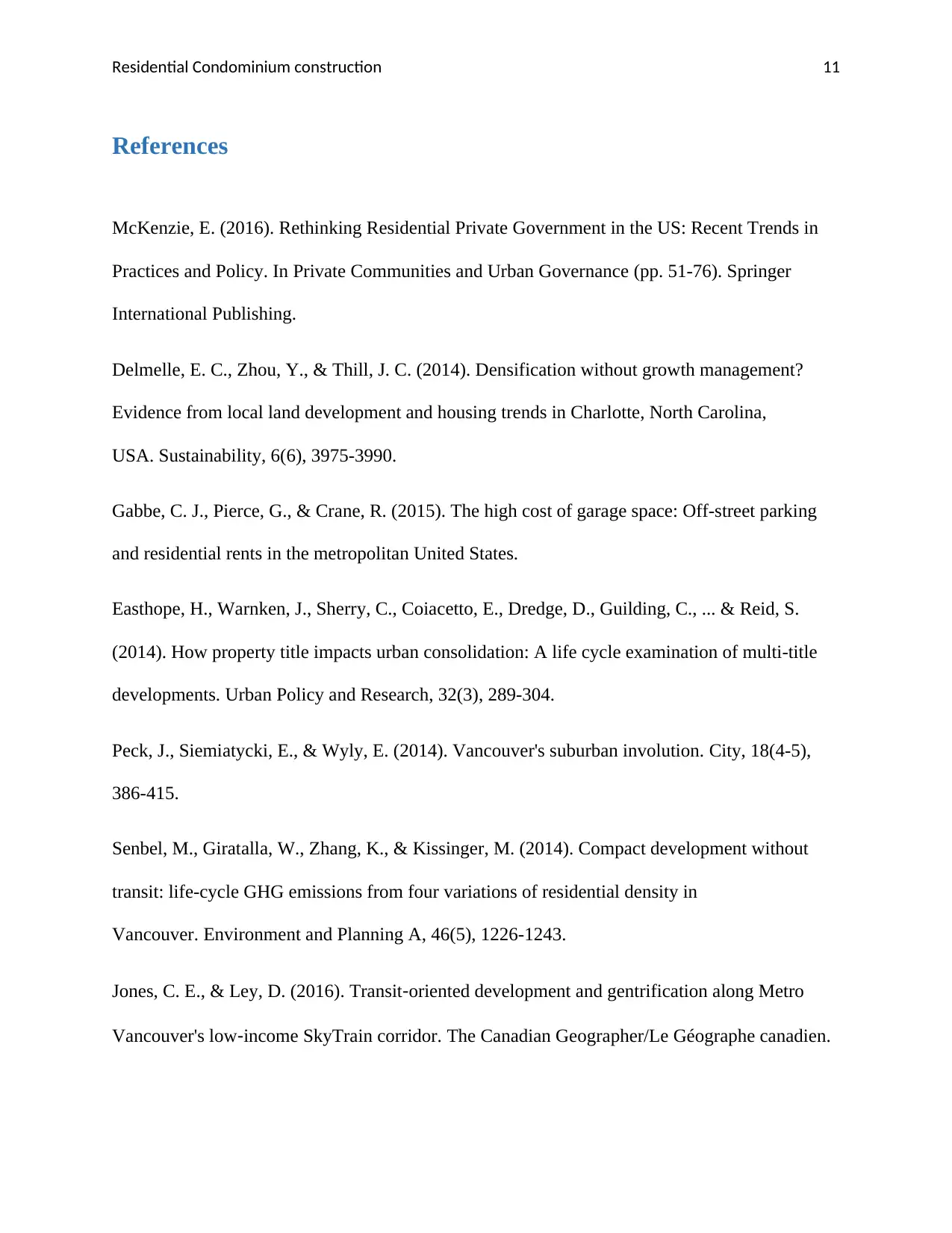
Residential Condominium construction 11
References
McKenzie, E. (2016). Rethinking Residential Private Government in the US: Recent Trends in
Practices and Policy. In Private Communities and Urban Governance (pp. 51-76). Springer
International Publishing.
Delmelle, E. C., Zhou, Y., & Thill, J. C. (2014). Densification without growth management?
Evidence from local land development and housing trends in Charlotte, North Carolina,
USA. Sustainability, 6(6), 3975-3990.
Gabbe, C. J., Pierce, G., & Crane, R. (2015). The high cost of garage space: Off-street parking
and residential rents in the metropolitan United States.
Easthope, H., Warnken, J., Sherry, C., Coiacetto, E., Dredge, D., Guilding, C., ... & Reid, S.
(2014). How property title impacts urban consolidation: A life cycle examination of multi-title
developments. Urban Policy and Research, 32(3), 289-304.
Peck, J., Siemiatycki, E., & Wyly, E. (2014). Vancouver's suburban involution. City, 18(4-5),
386-415.
Senbel, M., Giratalla, W., Zhang, K., & Kissinger, M. (2014). Compact development without
transit: life-cycle GHG emissions from four variations of residential density in
Vancouver. Environment and Planning A, 46(5), 1226-1243.
Jones, C. E., & Ley, D. (2016). Transit‐oriented development and gentrification along Metro
Vancouver's low‐income SkyTrain corridor. The Canadian Geographer/Le Géographe canadien.
References
McKenzie, E. (2016). Rethinking Residential Private Government in the US: Recent Trends in
Practices and Policy. In Private Communities and Urban Governance (pp. 51-76). Springer
International Publishing.
Delmelle, E. C., Zhou, Y., & Thill, J. C. (2014). Densification without growth management?
Evidence from local land development and housing trends in Charlotte, North Carolina,
USA. Sustainability, 6(6), 3975-3990.
Gabbe, C. J., Pierce, G., & Crane, R. (2015). The high cost of garage space: Off-street parking
and residential rents in the metropolitan United States.
Easthope, H., Warnken, J., Sherry, C., Coiacetto, E., Dredge, D., Guilding, C., ... & Reid, S.
(2014). How property title impacts urban consolidation: A life cycle examination of multi-title
developments. Urban Policy and Research, 32(3), 289-304.
Peck, J., Siemiatycki, E., & Wyly, E. (2014). Vancouver's suburban involution. City, 18(4-5),
386-415.
Senbel, M., Giratalla, W., Zhang, K., & Kissinger, M. (2014). Compact development without
transit: life-cycle GHG emissions from four variations of residential density in
Vancouver. Environment and Planning A, 46(5), 1226-1243.
Jones, C. E., & Ley, D. (2016). Transit‐oriented development and gentrification along Metro
Vancouver's low‐income SkyTrain corridor. The Canadian Geographer/Le Géographe canadien.
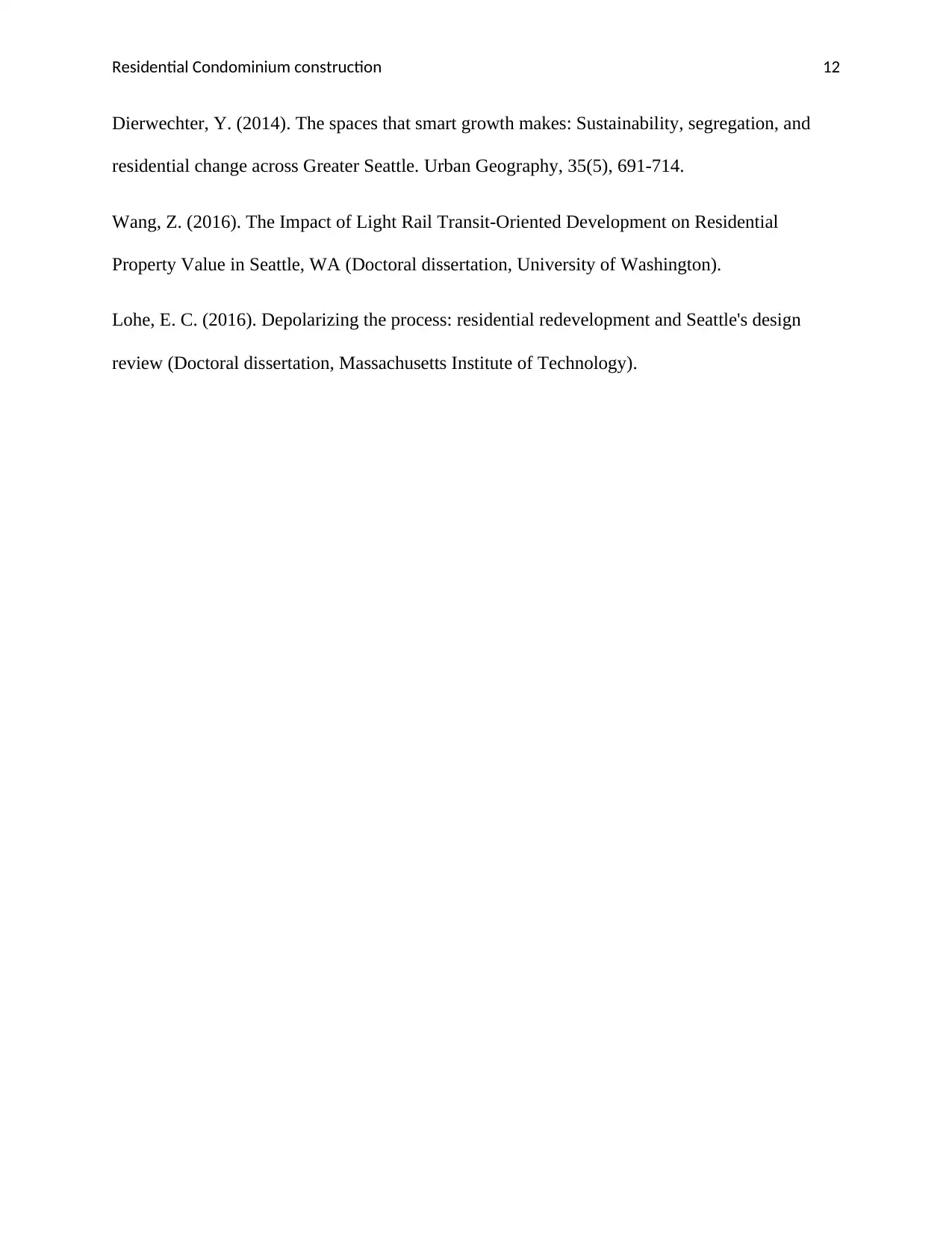
Residential Condominium construction 12
Dierwechter, Y. (2014). The spaces that smart growth makes: Sustainability, segregation, and
residential change across Greater Seattle. Urban Geography, 35(5), 691-714.
Wang, Z. (2016). The Impact of Light Rail Transit-Oriented Development on Residential
Property Value in Seattle, WA (Doctoral dissertation, University of Washington).
Lohe, E. C. (2016). Depolarizing the process: residential redevelopment and Seattle's design
review (Doctoral dissertation, Massachusetts Institute of Technology).
Dierwechter, Y. (2014). The spaces that smart growth makes: Sustainability, segregation, and
residential change across Greater Seattle. Urban Geography, 35(5), 691-714.
Wang, Z. (2016). The Impact of Light Rail Transit-Oriented Development on Residential
Property Value in Seattle, WA (Doctoral dissertation, University of Washington).
Lohe, E. C. (2016). Depolarizing the process: residential redevelopment and Seattle's design
review (Doctoral dissertation, Massachusetts Institute of Technology).
1 out of 13
Your All-in-One AI-Powered Toolkit for Academic Success.
+13062052269
info@desklib.com
Available 24*7 on WhatsApp / Email
![[object Object]](/_next/static/media/star-bottom.7253800d.svg)
Unlock your academic potential
© 2024 | Zucol Services PVT LTD | All rights reserved.